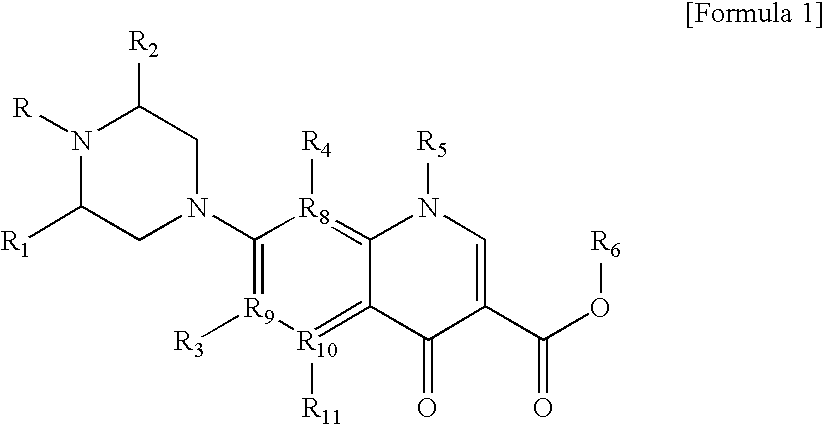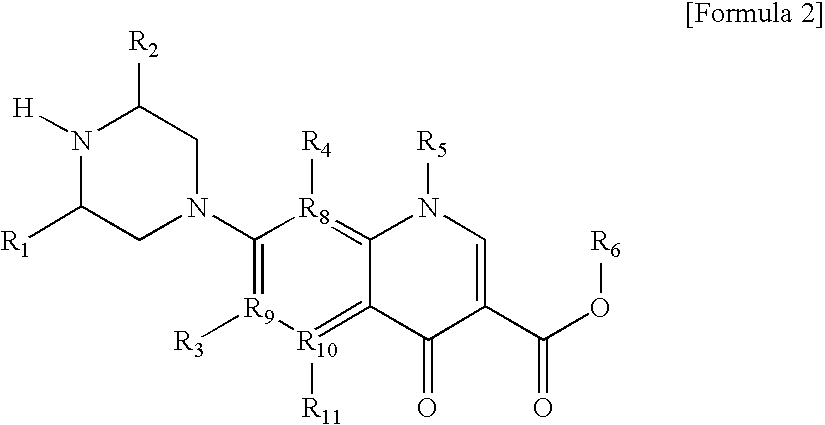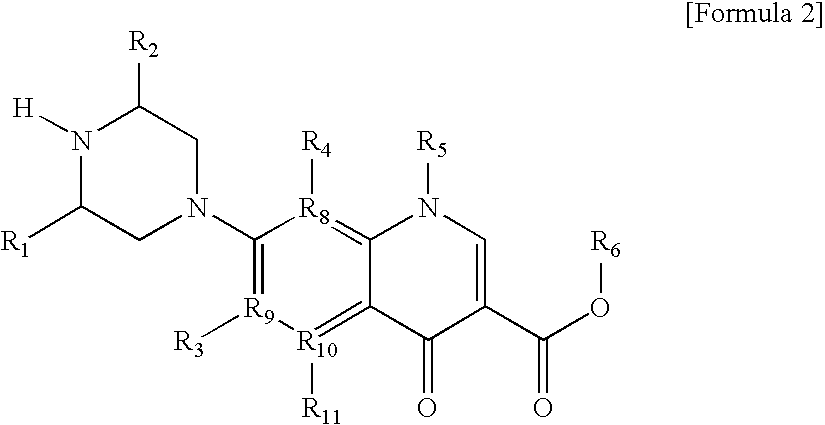Monomer with anti-microbial character, polymer using the same, and manufacturing method thereof
a monomer and antimicrobial technology, applied in the field of monomer with antimicrobial characteristics, can solve the problems of reducing antimicrobial ability, yellowing phenomenon, and technical limits of antimicrobial materials, and achieve excellent heat resistance and compatibility, and antimicrobial activity durable
- Summary
- Abstract
- Description
- Claims
- Application Information
AI Technical Summary
Benefits of technology
Problems solved by technology
Method used
Image
Examples
example 1
Manufacture of {1-Cyclopropyl-6-Fluoro-1,4-Dihydro-7-[4-(10,11-Epoxy-2,6-Dihydroxy-4,8-Dioxaundecyl)-3-Methyl-1-piperazinyl]-5-Methyl-4-Oxo-3-Quinoline Carboxylic Acid}
[0127] 15.0 ml of N,N-dimethylformamide were charged into a round 3-neck flask of 50 ml equipped with a thermometer and a stirring device, and 30.4 mg of 1-cyclopropyl-6-fluoro-1,4-dihydro-5-methyl-7-(3-methyl-1-piperazinyl)-4-oxo-3-quinoline carboxylic acid were added thereto and they were slowly stirred at room temperature for 10 minutes. 17.2 mg of glyceroldiglycidylether were added thereto and stirred. The reactants were washed with 1.2 ml of N,N-dimethylformamide, and they were reacted for 5 hours after their temperature was adjusted to 60° C. Thereafter, after cooling, they were stirred at 20° C. for 10 minutes. The reactants were obtained in a crystalized state from the layer of water and then dried to give 35.0 mg of 1-cyclopropyl-6-fluoro-1,4-dihydro-7-[4-(10,11-epoxy-2,6-dihydroxy-4,8-dioxaundecyl)-3-methyl-...
example 2
Manufacture of {1-Ethyl-6,8-Difluoro-1,4-Dihydro-7-[4-(2-Hydroxy-6-Methyl-4-Oxa-5-Oxo-6-Heptenyl)-3-M ethyl-1-Piperazinyl]-4-Oxo-3-Quinoline Carboxylic Acid}
[0129] 39.4 mg of 1-ethyl-6,8-difluoro-1,4-dihydro-7-(3-methyl-1-piperazinyl)-4-oxo-3-quinoline carboxylic acid were mixed with 10.0 ml of 2,6-dimethylpiperazine in a round flask of 50 ml and slowly stirred at room temperature for 10 minutes. 22.0 mg of glycidylmethacrylate were added thereto and stirred at room temperature, and then the reactants were washed with 2.0 ml of 2,6-dimethylpiperazine. Thereafter, the reaction was performed at 40° C. for 8 hours, and after the temperature was reduced to room temperature, the reaction was performed for another 8 hours. The crystalized reactants were obtained from the layer of water and dried to give 25 mg of 1-ethyl-6,8-difluoro-1,4-dihydro-7-[4-(2-hydroxy-6-methyl-4-oxa-5-oxo-6-heptenyl)-3-methyl-1-piperazinyl]-4-oxo-3-quinoline carboxylic acid.
[0130]1H-NMR (DMSO-d6) δ 1.10 (3H, d),...
example 3
Manufacture of {8-Ethyl-5,8-Dihydro-2-{4-[2-Hydroxy-3-(4-Nonylphenoxy)Propyl]-1-piperazinyl}-5-Oxopyrido[2,3-d]Pyrimidine-6-Carboxylic Acid}
[0131] 38.0 mg of 8-ethyl-5,8-dihydro-5-oxo-2-(1-piperazinyl)pyrido{2,3-d}pyrimidine-6-carboxylic acid were mixed with 12.0 ml of dimethylsulfoxide in a round flask of 50 ml and slowly stirred at room temperature for 10 minutes. 18.0 mg of glycidylnonylphenylether were added thereto, it was stirred again at room temperature, and then washed with 12 ml of dimethylsulfoxide. The reactants were placed at 50° C. for 11 hours, and then stirred at 20° C. for 10 minutes. The reactants were crystalized from isopropyl alcohol and the layer of water with methylene chloride, filtered, and then dried to give 37.2 mg of 8-ethyl-5,8-dihydro-2-{4-[2-hydroxy-3-(4-nonylphenoxy)propyl]-1-piperazinyl}-5-oxo pyrido[2,3-d]pyrimidine-6-carboxylic acid.
[0132]1H-NMR (DMSO-d6) δ 0.88 (3H, t), 1.10˜1.70 (17H, m), 2.45˜3.05 (10H, m), 3.35˜3.55 (4H, m), 3.92˜4.12 (3H, m),...
PUM
| Property | Measurement | Unit |
|---|---|---|
| temperature | aaaaa | aaaaa |
| temperature | aaaaa | aaaaa |
| temperature | aaaaa | aaaaa |
Abstract
Description
Claims
Application Information
 Login to View More
Login to View More - R&D
- Intellectual Property
- Life Sciences
- Materials
- Tech Scout
- Unparalleled Data Quality
- Higher Quality Content
- 60% Fewer Hallucinations
Browse by: Latest US Patents, China's latest patents, Technical Efficacy Thesaurus, Application Domain, Technology Topic, Popular Technical Reports.
© 2025 PatSnap. All rights reserved.Legal|Privacy policy|Modern Slavery Act Transparency Statement|Sitemap|About US| Contact US: help@patsnap.com



